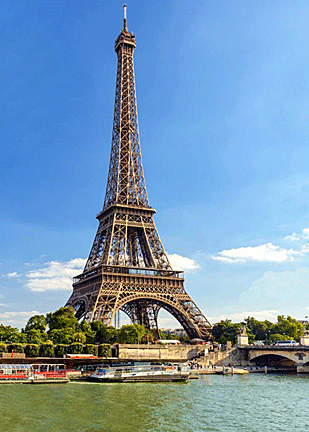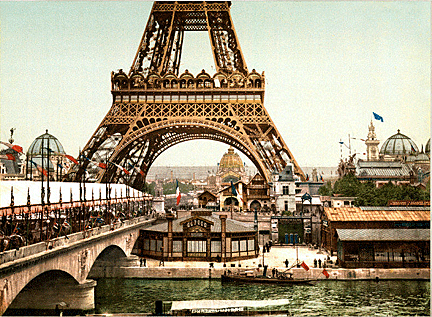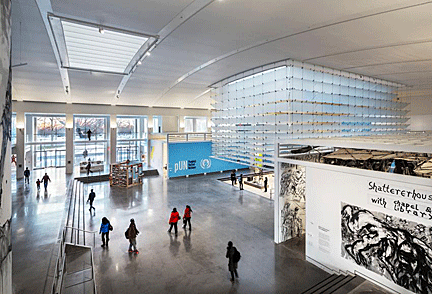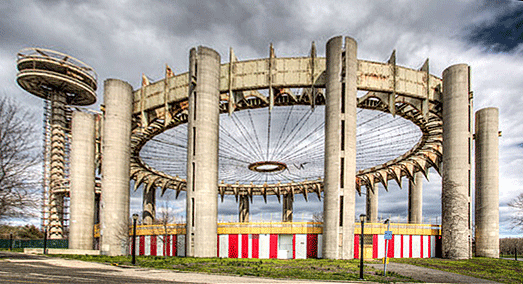|
Remnants of World's Fairs Gone By
by Bob Brooke
 Of
all the world’s fairs, except the first one in 1851, a few remnants
remain. Some of these are spectacular, such as the Eiffel Tower in
Paris, the Space Needle in Seattle, and the Unisphere in New York, the
Atomium in Brussels. Other buildings from the fairs of the past have
been repurposed. One such building is the Ohio House, now a small cozy
café in Fairmont Park in Philadelphia, a forgotten remnant of the
Philadelphia Centennial Exposition held in 1876. Of
all the world’s fairs, except the first one in 1851, a few remnants
remain. Some of these are spectacular, such as the Eiffel Tower in
Paris, the Space Needle in Seattle, and the Unisphere in New York, the
Atomium in Brussels. Other buildings from the fairs of the past have
been repurposed. One such building is the Ohio House, now a small cozy
café in Fairmont Park in Philadelphia, a forgotten remnant of the
Philadelphia Centennial Exposition held in 1876.
Originally one of 24 small buildings housing state exhibits at that
world’s fair, a few others of which were dismantled and shipped to
far-flung places in the U.S. to be repurposed for other uses, it stands
quietly among the shade trees across the road from Memorial Hall, the
only major building left from that fair, now the home of the Please
Touch Museum.
 International
expositions have produced some of the most innovative works of
architecture over the past two centuries. Though the majority of these
structures are temporary and are dismantled after a fair closes,
landmark towers from several fairs are notable exceptions. By far the
most famous of these is the Eiffel Tower, built for the Exposition
Universelle, held in Paris in 1889. International
expositions have produced some of the most innovative works of
architecture over the past two centuries. Though the majority of these
structures are temporary and are dismantled after a fair closes,
landmark towers from several fairs are notable exceptions. By far the
most famous of these is the Eiffel Tower, built for the Exposition
Universelle, held in Paris in 1889.
For nearly 170 years, world’s fairs have captivated international
audiences, showing off the technological, scientific, and cultural
achievements of countries across the globe. The first widely recognized
exposition was London’s 1851 Great Exhibition of the Works of Industry
of All Nations, established by Prince Albert, for which Joseph Paxton
designed the impressive Crystal Palace to house the exhibits. The
cast-iron and glass structure was a marvel, and it set the precedent for
future world’s fairs to showcase feats of architecture and engineering.
Though the Crystal Palace burned down in 1936, and many other world’s
fair structures have been dismantled over time, there are still a few
that remain today.
World’s fairs exist to provide a glimpse into the future. They have
showcased technological breakthroughs like the telephone introduced at
the 1876 Philadelphia Centennial Exposition and the diesel engine that
chugged along at the Paris fair in 1900, powered by peanut oil. Many of
the gadgets they introduced have become part of everyday life.
 Though
fire destroyed London’s Crystal Palace from the first world's fair in
1936, the decades have been kinder to another 19th-century relic—the
1,063-foot-tall wrought-iron Eiffel Tower—designed by architect and
engineer Gustave Eiffel’s company as the gateway arch to the 1889
Universal Exposition in Paris. A group of French artists, authors and
architects called the arch “useless and monstrous” and predicted that it
would be “a giddy, ridiculous tower dominating Paris like a gigantic
black smokestack.” They had a point, but if you’ve been to the city,
you’ve probably noticed that the arch, the Eiffel Tower, is not only
still there but has become a symbol of the Paris, itself, the City of
Light. Though
fire destroyed London’s Crystal Palace from the first world's fair in
1936, the decades have been kinder to another 19th-century relic—the
1,063-foot-tall wrought-iron Eiffel Tower—designed by architect and
engineer Gustave Eiffel’s company as the gateway arch to the 1889
Universal Exposition in Paris. A group of French artists, authors and
architects called the arch “useless and monstrous” and predicted that it
would be “a giddy, ridiculous tower dominating Paris like a gigantic
black smokestack.” They had a point, but if you’ve been to the city,
you’ve probably noticed that the arch, the Eiffel Tower, is not only
still there but has become a symbol of the Paris, itself, the City of
Light.
The Centennial Exposition's main building, Memorial Hall, still stands
majestically in Philadelphia’s Fairmount Park. The space under it’s
entrance now houses a scale model of the entire Exposition.

The Palace of Fine Arts from the 1893 World Columbian Exposition in
Chicago is one of that fair’s last remaining buildings. It now houses
the Museum of Science and Industry. Though the majority of the fair’s
buildings were designed as temporary structures, the Fair Committee
built the Palace of Fine Arts more sturdily with brick covered in white
plaster, and it became home to the Field Museum after the exposition. In
the 1930s, as part of the building’s transition into the Museum of
Science and Industry, the façade was re-cast in limestone to ensure its
permanence.

The World's Congress Auxiliary Building from the 1893 Fair is now the
home of the Art Institute of Chicago. A construction project by the
University of Chicago unearthed the foundation of the first Ferris
Wheel, which operated at the Exposition on the Midway. Relocated
survivors include the Norway pavilion, a small house now at a museum in
Wisconsin, and the Maine State Building, now at the Poland Springs
Resort in Maine.
 The
Japanese Tea Garden in San Francisco's Golden Gate Park is the last
major remnant of the California Midwinter International Exposition, held
in San Francisco in 1894. The addition of large ornamental wooden gates
and a pagoda from the 1915 Panama-Pacific International Exposition
brought in after the latter fair closed have made the Tea Garden a
unique instance of a survivor that incorporates architectural features
from two different fairs. The
Japanese Tea Garden in San Francisco's Golden Gate Park is the last
major remnant of the California Midwinter International Exposition, held
in San Francisco in 1894. The addition of large ornamental wooden gates
and a pagoda from the 1915 Panama-Pacific International Exposition
brought in after the latter fair closed have made the Tea Garden a
unique instance of a survivor that incorporates architectural features
from two different fairs.
The Grand Palais and Petit Palais, remaining from the Univerelle
Exposition of 1900 in Paris, now house art museums.
The New York City Building from the 1939's World Fair, reused for the
1964 World's Fair, now houses the Queens Art Museum, containing an
exhibit of New York World’s Fair memorabilia.

The Atomium, a 165-billion-times-enlarged iron-crystal-shaped building,
still stands at the exposition site of the Brussels World’s Fair, held
in 1958,and is now a museum.
 The
Space Needle, the iconic theme building of the Century 21 Exposition,
held in 1962, commonly known as the Seattle World's Fair, still stands
as a symbol of Seattle and its chief landmark. The 605-foot-tall flying
saucer–shaped tower, originally housing two restaurants and an
observation deck. The Seattle Center Monorail, the other widely known
"futuristic" feature of the fair, still operates daily. The US pavilion
became the Pacific Science Center. The
Space Needle, the iconic theme building of the Century 21 Exposition,
held in 1962, commonly known as the Seattle World's Fair, still stands
as a symbol of Seattle and its chief landmark. The 605-foot-tall flying
saucer–shaped tower, originally housing two restaurants and an
observation deck. The Seattle Center Monorail, the other widely known
"futuristic" feature of the fair, still operates daily. The US pavilion
became the Pacific Science Center.
Many structures still stand from the 1964-65 New York World’s Fair,
including the Unisphere and the Singer Bowl stadium, since converted
into Louis Armstrong Stadium, part of the Billie Jean King National
Tennis Center, site of the US Open. The New York Hall of Science, built
for the fair, continues to operate as a science museum, similar to its
original role. The Port Authority Heliport and Exhibit is now the
Terrace on the Park event and catering venue.

The New York State Pavilion from the 1964-65 Fair stands derelict, with
its observation towers most prominently featured in the 1997 film Men In
Black. The Theaterama building remains in use by the Queens Theater.
Although there are plans to restore the main Tent of Tomorrow building,
nothing has been done as yet.

Among the structures still standing from Expo 67 in Montreal are Moshe
Safdie's Habitat 67, a model for pre-fabricated urban housing design
that’s still in use as a residence, the Jamaica Pavilion, the Tunisia
Pavilion, the French Pavilion, now the Montreal Casino, and the
“Montreal Biosphere.” American Architect Buckminster Fuller produced a
203-foot-high geodesic dome to serve as the U.S. Pavilion. While the
acrylic shell that enclosed the pavilion burned down in 1976, the stree
trusses remained, and today it’s part of the Biosphere Environment
Museum.

San Antonio kept the Tower of the Americas from HemisFair68, as well as
the Institute of Texan Cultures and the Convention Center.
<
More Special Features
Next Article > |
